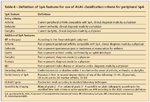Article
New Axial and Peripheral Spondyloarthritis Classification Criteria
The spectrum of spondyloarthritis disorders-typically including ankylosing spondylitis, arthritis associated with inflammatory bowel disease, reactive arthritis, psoriatic arthritis, and undifferentiated SpA-are related clinically and genetically but are distinct entities.
ABSTRACT: Spondyloarthritis (SpA) disorders have shared clinical features and are related clinically and genetically but are distinct entities. The Assessment of SpondyloArthritis international Society (ASAS) has developed new classification criteria for axial SpA and peripheral SpA; the older criteria did not specifically differentiate between them. The New York criteria were developed before the routine use of MRI in clinical medicine, making sacroiliitis on plain radiographs an essential element and leading to poor sensitivity and a delay in diagnosis. The new ASAS criteria for axial SpA are designed to help clinicians make an earlier diagnosis and facilitate clinical trials. Classification criteria are meant to be applied in clinical trials but also are helpful in establishing a diagnosis in patients who are referred to a rheumatology practice. (J Musculoskel Med. 2011;28:454-457)
The spectrum of spondyloarthritis (SpA) disorders-typically including ankylosing spondylitis (AS), arthritis associated with inflammatory bowel disease (IBD), reactive arthritis, psoriatic arthritis, and undifferentiated SpA-are related clinically and genetically but are distinct entities. Shared clinical features include inflammatory back pain (IBP); oligoarticular and asymmetrical peripheral arthritis, with a lower limb predilection; enthesitis; dactylitis; and uveitis. To varying degrees, SpA disorders are associated with the HLA-B27 gene, supporting a genetic basis.1,2 They also may be categorized according to their predominant clinical manifestations as involving primarily axial symptoms (IBP in the sacroiliac joints or spine or both) or peripheral symptoms (peripheral arthritis, enthesitis, and dactylitis), with possible overlap.
Recently, the Assessment of SpondyloArthritis international Society (ASAS) developed new classification criteria for both axial SpA and peripheral SpA. Although SpA conditions have the many similarities described above, they also have several genetic, prognostic, and therapeutic differences. Therefore, grouping together all “peripheral SpA” under 1 umbrella is open for criticism from specialists, who tend to be “splitters” rather than “lumpers.”
This is the second in a series of articles that describe new or modified classification and diagnostic criteria for various rheumatologic conditions. The first article (“New classification criteria for RA,” The Journal of Musculoskeletal Medicine, November 2011) discussed recent revisions in rheumatoid arthritis classification criteria. In this article, we review the new classification criteria for SpA.
The need for new criteria
Two of the older sets of criteria frequently used to make a diagnosis of SpA-the Amor criteria3 and the European Spondyloarthropathy Study Group (ESSG) criteria4-did not specifically differentiate between peripheral SpA and axial SpA. However, the modified New York criteria were developed specifically to classify patients with AS, but not other SpA subtypes.
The New York criteria were developed in 1984, before the routine use of MRI in clinical medicine; therefore, sacroiliitis on plain radiographs is an essential element.2 However, this requirement inherently leads to poor sensitivity for classifying early disease and results in a delay in diagnosis-it may take up to 6 to 8 years for sacroiliitis to become apparent on plain radiographs after the onset of IBP. Also, by the time sacroiliitis is apparent on plain radiographs, it reflects “joint damage” rather than “active inflammation.”1,5
More recently, MRI has dramatically improved the imaging of sacroiliitis with or without structural damage. The new ASAS criteria for axial SpA are designed to help clinicians make an earlier diagnosis in patients with or without radiographic sacroiliitis and facilitate clinical trials with such patients.6 In addition, the new ASAS criteria for peripheral SpA meet a need for specific criteria for this subgroup, which had been lacking.7
The process of developing new criteria
For the development of axial SpA classification criteria, 20 internationally recognized experts in the field of SpA (all ASAS members) reviewed 71 “paper patients”-including those without radiographic sacroiliitis-to draft candidate criteria based on clinical reasoning. The criteria were tested, refined, and validated in a large prospective study cohort of 649 patients worldwide. For eligibility, patients were required to have had at least 3 months of chronic back pain that started before age 45 years, with or without peripheral symptoms. To avoid selection bias, the investigators enrolled patients in a consecutive manner and provided them with a diagnostic workup that included a history, examination, laboratory testing (including the HLA-B27 gene), and imaging (radiography and MRI).
Plain radiographs were graded according to the modified New York criteria. An MRI result was considered “positive” only if bone marrow edema was seen periarticular to the sacroiliac joint on consecutive MRI slices; this definition of a positive MRI result was based on agreement among radiologists and rheumatologists in the ASAS/Outcome Measures in Rheumatology network MRI consensus group. An expert ASAS rheumatologist determined whether a clinical diagnosis of axial SpA could be made along with a confidence rating; this was considered the gold standard.5,6
TABLE 1

ASAS axial SpA classification criteria
A diagnosis of axial SpA was made in 60% of the patients in the cohort; 70% of them did not fulfill the modified New York criteria. Consequently, the new classification criteria have an “imaging arm,” with the presence of sacroiliitis by radiography or MRI plus at least 1 SpA feature, and a “clinical arm,” with the presence of the HLA-B27 gene plus at least 2 SpA features.
TABLE 2

Definition of parameters applied in the classification criteria for axial SpA
The sensitivity and specificity were 82.9% and 84.4%, respectively, for the entire set of the new criteria, and 66.2% and 97.3%, respectively, for the imaging arm alone. They were greater than in the ESSG criteria and the Amor criteria modified for MRI.5,6
TABLE 3

ASAS peripheral SpA classification criteria
The development of classification criteria for peripheral SpA was similar to that for axial SpA. Newly referred patients who were enrolled in the study consecutively did not have back pain and an onset of symptoms before age 45 years but had 1 or more of the following conditions: undiagnosed peripheral arthritis, dactylitis, and enthesitis. A total of 266 patients worldwide underwent a diagnostic and radiographic workup similar to that in the axial arm. Again, an expert ASAS rheumatologist made the clinical diagnosis with a confidence rating, and it was considered the gold standard.2,7
A diagnosis of peripheral SpA was made in 66.2% of patients by using the criteria; after testing with refinement, the classification criteria showed a sensitivity of 77.8% and specificity of 82.9%. The criteria include arthritis or enthesitis or dactylitis plus (a) 1 or more of the following: psoriasis, IBD, preceding infection, the HLA-B27 gene, uveitis, and sacroiliitis on imaging, or (b) 2 or more of the following: arthritis, dactylitis, enthesitis, family history of SpA, and history of IBP.
Again, the new criteria performed better than the modified ESSG criteria or the Amor criteria. The combined axial and peripheral SpA criteria had a sensitivity of 79.5% and specificity of 83.3%, which also were greater than in the modified ESSG criteria and the Amor criteria.7
TABLE 4

Definition of SpA features for use of ASAS classification criteria for peripheral SpA
How the new criteria differ from the old
Development of the new ASAS classification criteria has fulfilled the need for classifying 2 separate but related clinical entities: axial SpA (Tables 1 and 2) and peripheral SpA (Tables 3 and 4). The older criteria did not distinguish between them.
In addition, MRI was not a part of the older criteria for classifying AS, but it now is recognized as the most sensitive imaging study for active inflammation in the sacroiliac joints, with high specificity.2 The use of MRI helps identify patients without radiographic sacroiliitis; consequently, a population of patients that the older criteria did not include now are classified under the new designation of axial SpA. The axial SpA criteria are divided into 2 separate arms, with the HLA-B27 gene playing an important role in one of them.
The advantages and potential uses of the new criteria
Although classification criteria are meant to be applied in clinical trials, they also are helpful in establishing a diagnosis when applied to patients who are referred to a rheumatology practice with suspected SpA. Because the new criteria are more sensitive and specific than the previous criteria, diagnostic accuracy is improved and earlier diagnosis is possible. Patients who have nonradiographic SpA not only will be included in studies but also will be eligible for effective treatment sooner than in the past.
References:
References
1. Rudwaleit M. New approaches to diagnosis and classification of axial and peripheral spondyloarthritis. Curr Opin Rheumatol. 2010;22:375-380.
2. van den Berg R, van der Heijde DM. How should we diagnose spondyloarthritis according to the ASAS classification criteria: a guide for practicing physicians. Pol Arch Med Wewn. 2010;120:452-457.
3. Amor B, Dougados M, Mijiyawa M. Criteria of the classification of spondylarthropathies [in French]. Rev Rhum Mal Osteoartic. 1990;57:85-89.
4. Dougados M, van der Linden S, Juhlin R, et al. The European Spondyloarthropathy Study Group preliminary criteria for the classification of spondyloarthropathy. Arthritis Rheum. 1991;34:1218-1227.
5. Rudwaleit M, van der Heijde D, Landewé R, et al. The development of Assessment of SpondyloArthritis international Society classification criteria for axial spondyloarthritis (part II): validation and final selection. Ann Rheum Dis. 2009;68:777-783.
6. Rudwaleit M, Landewé R, van der Heijde D, et al. The development of Assessment of SpondyloArthritis international Society classification criteria for axial spondyloarthritis (part I): classification of paper patients by expert opinion including uncertainty appraisal [published correction appears in Ann Rheum Dis. 2011;70:1519]. Ann Rheum Dis. 2009;68:770-776.
7. Rudwaleit M, van der Heijde D, Landewé R, et al. The Assessment of SpondyloArthritis International Society classification criteria for peripheral spondyloarthritis and for spondyloarthritis in general. Ann Rheum Dis. 2011;70:25-31.




